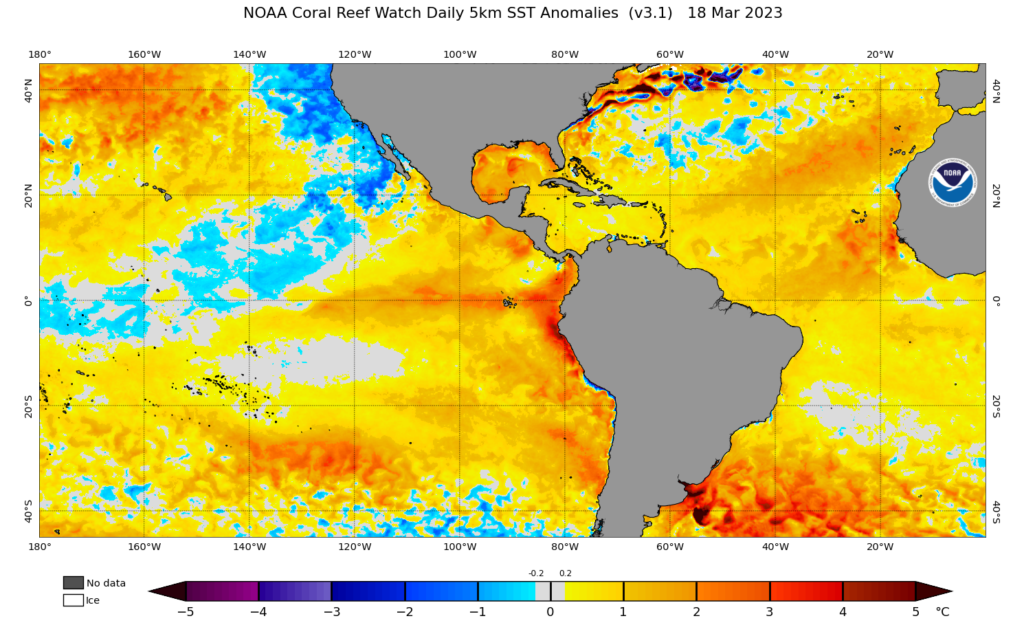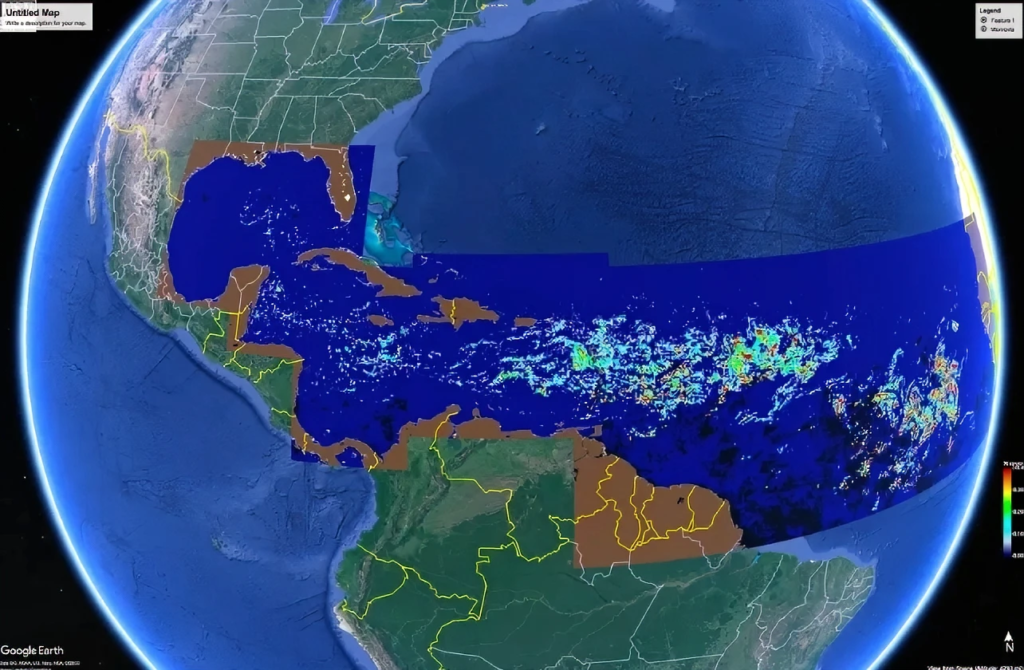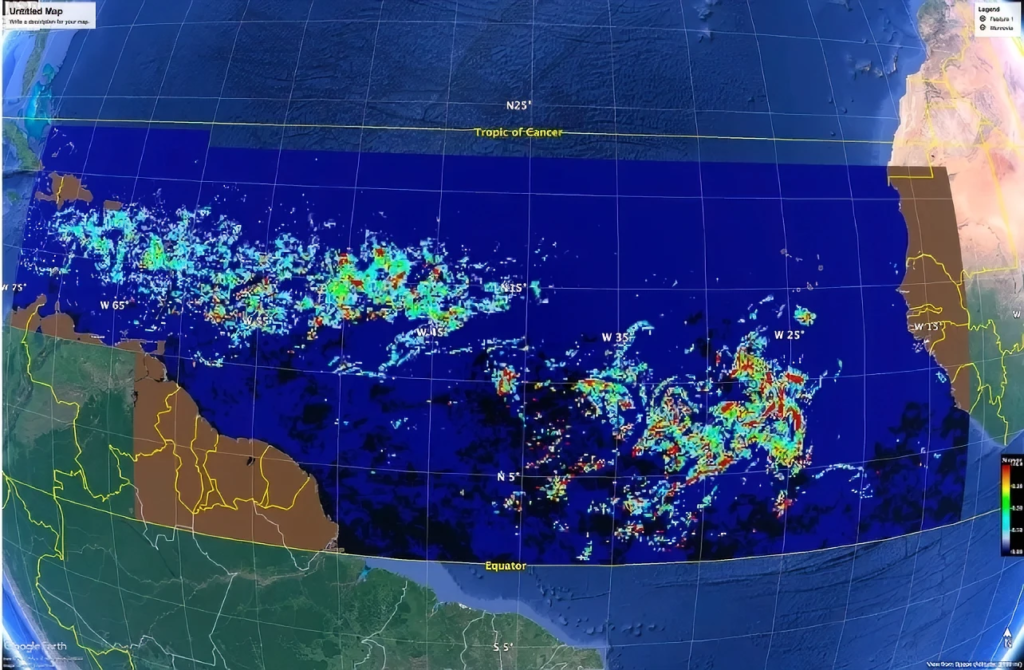The main purpose of this ongoing blog will be to track global extreme or record temperatures related to climate change. Any reports I see of ETs will be listed below the main topic of the day. I’ll refer to extreme or record temperatures as ETs (not extraterrestrials).😉
Main Topic: Climate Crisis Related Record Large Algae Bloom Approaches Florida
Dear Diary. Our seas are currently at record warm levels:
So, it comes as no surprise that there are consequences for all of this warmth due to our long-term burning of fossil fuels. I contend that we would not have a record large algae bloom in the Carribean if it were not for climate change. This bloom appears to be nurtured by extra carbon absorbed by the oceans, anomalous warmth, and fertilizer pollution spilling into the Atlantic; however, scientists caution that the reason for its existence is not so clear cut:
Here is a close up of temperature anomalies over the Gulf and Caribbean + the mid-Atlantic depicting a ton of anomalous warmth:

For today’s main topic let’s repost that Science Alert article to learn more:
Satellites Reveal Sheer Size of Record-Breaking Algae Bloom Approaching Florida : ScienceAlert
Satellites Reveal Sheer Size of Record-Breaking Algae Bloom Approaching Florida
ENVIRONMENT17 March 2023
By ISOBEL VAN HAGEN ET AL., BUSINESS INSIDER

The Sargassum bloom approaching Florida, seen from space. (Chuanmin Hu/University of South Florida College of Marine Science)
An enormous stretch of seaweed measuring 5,000 miles (8,047 kilometers) wide is set to bring stench, pests, and bacteria to the beaches of Florida and Mexico.
The “Great Atlantic Sargassum Belt” is a massive bloom of brown algae that stretches from the coast of West Africa to the Gulf of Mexico. It is the largest seaweed bloom in the world – weighing approximately 20 million tons – and is visible from outer space.
This year’s bloom is the biggest on record for the month of March, and it’s expected to grow from here, peaking in June or July. Scientists are increasingly concerned about the impacts of the algae.
It’s important to note that seaweed is usually fairly innocuous and actually has benefits like providing habitats for fish and absorbing carbon dioxide. But that’s when it’s out in the open ocean.
Sargassum, like the bloom spanning about twice the width of the US right now, could wreak havoc on beaches as ocean currents push the brown algae towards land.
Because once the seaweed reaches shore, “the [blooms] degrade water quality, they smell bad, they attract insects and bacteria, they chase away tourists. It’s a bad impact on the economy,” Chuanmin Hu, professor of oceanography at the University of Miami who leads a team to monitor and track sargassum blooms using satellites, told Insider.

A satellite map of the Sargassum bloom approaching Florida, from March 7-13, 2023. (Chuanmin Hu/University of South Florida College of Marine Science)
The algae can also destroy coastal ecosystems, suffocate coral, harm wildlife, threaten infrastructure, and decrease air quality.
As beached sargassum dies and rots, it has a distinct rotten-egg smell, which has caused a huge problem for tourism in both Mexico and Florida.
Hotels and resorts in Mexico, for example, spend millions each year to get rid of beaches of sargassum, hiring workers to collect it and move it elsewhere.
“Increasing sargassum blooms are good for the ocean ecosystem, but pretty bad for some local residents,” Hu said.
It’s a mystery why sargassum blooms are growing
There are hundreds of different species of sargassum. Some of those that populate the Atlantic Ocean grow on the surface of the water, since they don’t form roots to attach themselves to rocks like other algae.
This makes it easy for small clumps to move together and form larger clumps as winds between South Africa and the Gulf of Mexico push them together, Hu said. That’s what makes the great seaweed belt across the Atlantic each spring and summer.
“We have a lot of such clumps, but only 0.1 percent of the ocean surface within this belt is covered by this plant,” Hu said. “Sargassum does not fully cover any part of the ocean, and sargassum is not toxic.”
Still, the consequences of the Sargassum Belt have concerned scientists for the past decade. Experts say this year’s bloom is particularly alarming, according to reporting by Denise Chow for NBC News published Saturday.
“It’s incredible,” Brian LaPointe, a research professor at Florida Atlantic University’s Harbor Branch Oceanographic Institute, told NBC News. “What we’re seeing in the satellite imagery does not bode well for a clean beach year.”

A satellite map of the Sargassum bloom from March 8-14, 2023. (Chuanmin Hu/University of South Florida College of Marine Science)
LaPointe, who has studied sargassum for four decades, told the news outlet that beaches in Key West are already being covered with the algae, despite the piles usually washing ashore in May. Beaches in Mexico – like in Cancun, Playa del Carmen, and Tulum – are also preparing for a large build-up of sargassum this week.
Blooms have continued to grow, on average, larger and larger over the past five years. In 2018 and 2022 having record-breaking increases, Brian Barnes, an assistant research professor at the University of South Florida’s College of Marine Science, told NBC News.
This year is approaching these records, and could surpass them, Hu said.
One study in 2019 suggested that deforestation and fertilizer use may be responsible for the alarming rate at which the mass is growing – the effects of which are all exacerbated by climate change.
“I think I’ve replaced my climate change anxiety with sargassum anxiety,” Patricia Estridge, CEO of Seaweed Generation, told The Guardian.
“Both climate change and human activity play a role, but nobody can tell how much each one contributes to this. There are multiple factors because the Atlantic ocean is huge,” Hu said. “It’s a complex picture. That’s all we can say now, and we’re still doing research to understand why.”
This article was originally published by Business Insider.
Here are some “ET’s” recorded from around the planet the last couple of days, their consequences, and some extreme temperature outlooks, as well as any extreme precipitation reports:
Here is more climate and weather news from Sunday:
(As usual, this will be a fluid post in which more information gets added during the day as it crosses my radar, crediting all who have put it on-line. Items will be archived on this site for posterity. In most instances click on the pictures of each tweet to see each article. The most noteworthy items will be listed first.)
If you like these posts and my work please contribute via the PayPal widget, which has recently been added to this site. Thanks in advance for any support.)
Guy Walton… “The Climate Guy”